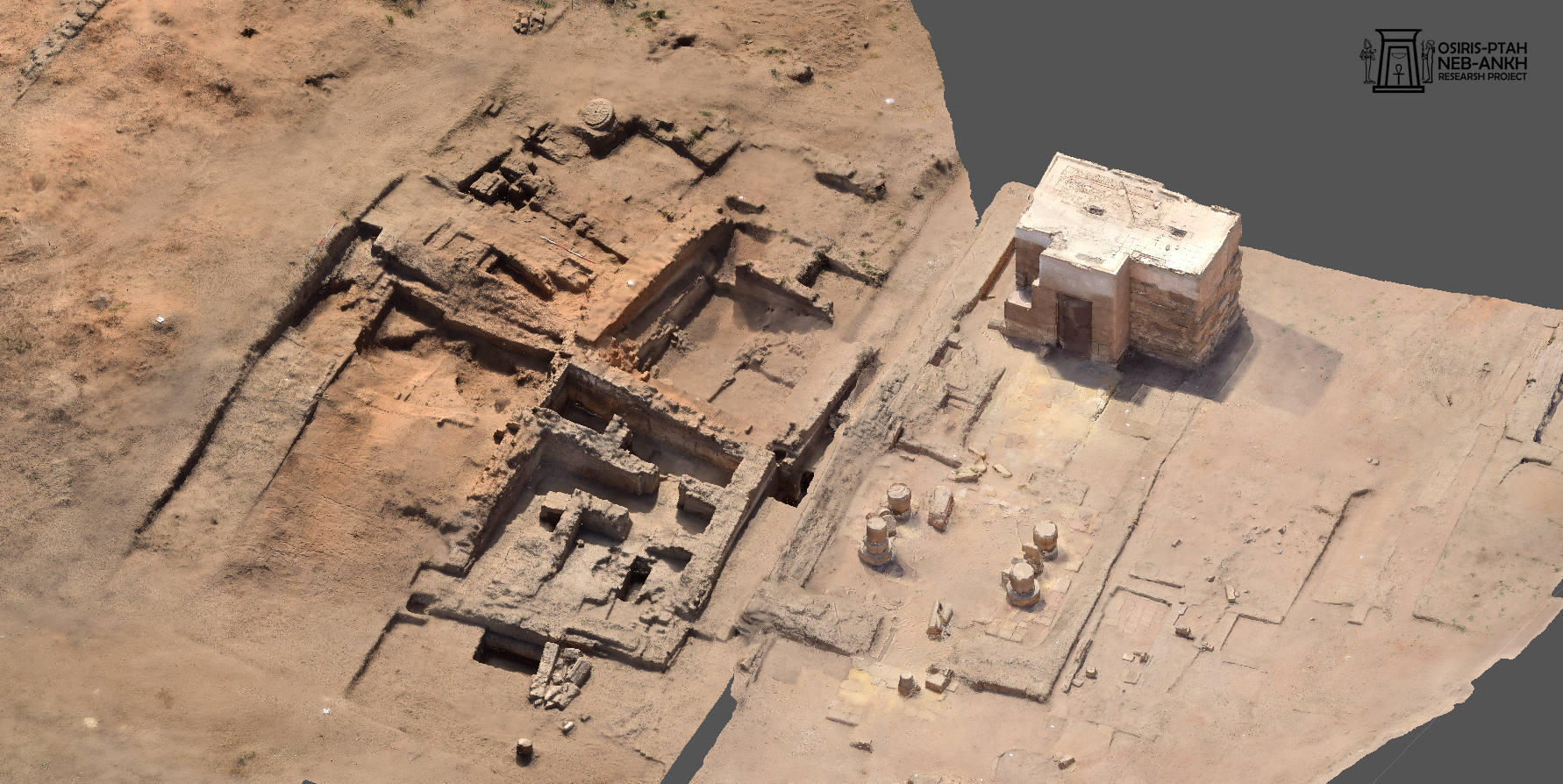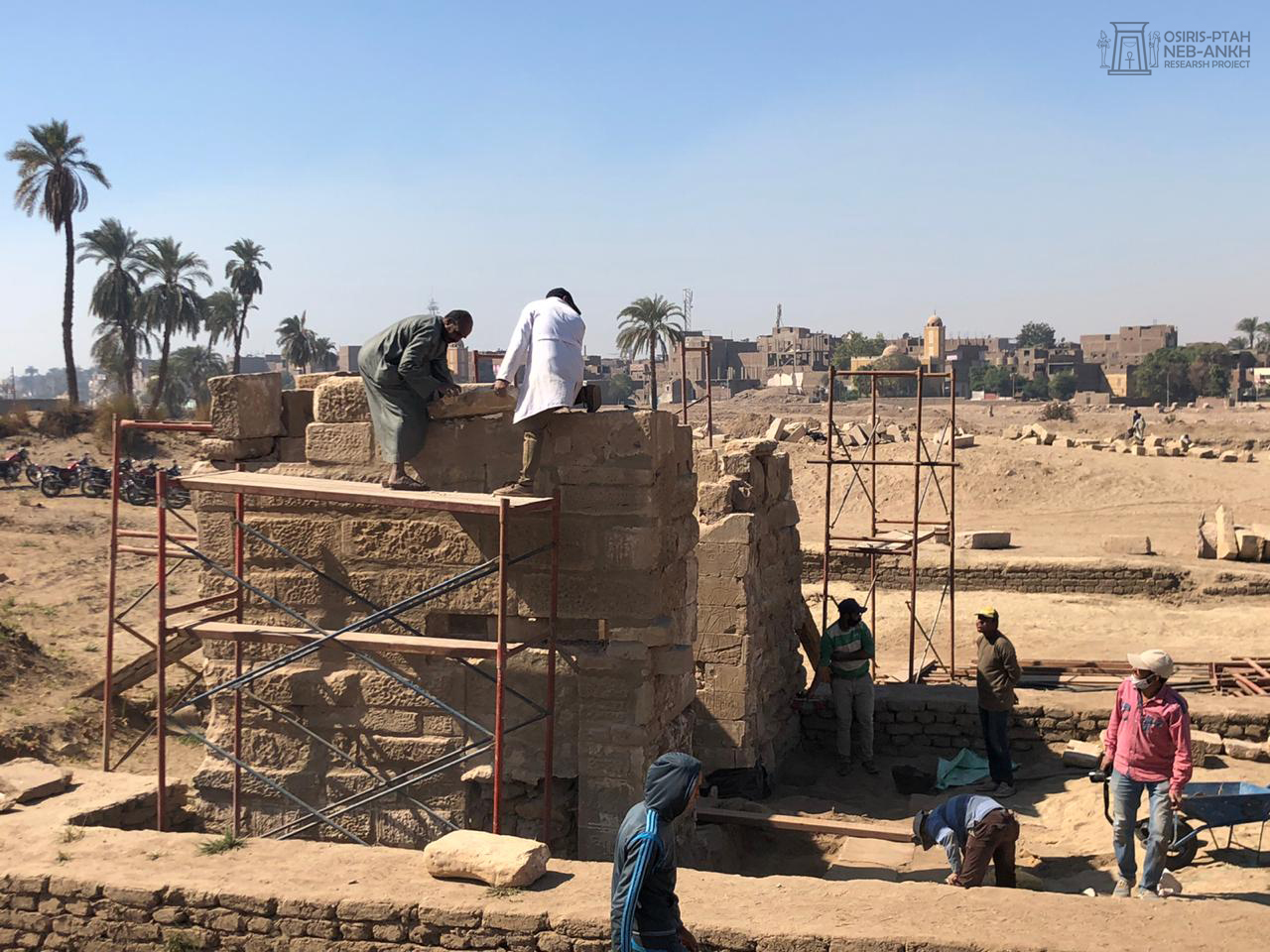- Era25th Dynasty
- Project DirectorDr. Essam Nagy
- LocationSouth Karnak, Luxor
- AffiliationEgyptian Ministry of Tourism and Antiquities
- Project SponsorAntiquities Endowment Fund
- Project DatesNovember 2020- October 2021
Located on Luxor’s East Bank, Karnak Temple is the largest temple complex in ancient Egypt. The 25th Dynasty Chapel of Osiris-Ptah Neb-ankh ‘Lord of Life’ lies to the south of the Tenth Pylon of the Amun-Re precinct and east of the ram-headed avenue of sphinxes that runs from the Tenth Pylon to the Mut precinct. This somewhat isolated monument is one of a series of Osirian chapels built by the Kushite pharaohs Taharqo and Tantamani. Both kings, as is to be expected, were represented in the scenes of the chapel, performing ritual offerings to various gods including the Lord of Life himself.
General view for the chapel and the surrounding area.
When the Chapel of Osiris-Ptah Neb-ankh was discovered by locals in 1875, it was in poor condition. In 1921–1922, Maurice Pillet, undertook some cleaning and restoration work, building a wooden ceiling and a door in order to protect the chapel from the rain. The chapel is built of local sandstone and contains two almost square rooms: an eastern room (Room I) and a western room (Room II). The two rooms are decorated with shallow sunken and painted reliefs, and these representations are a clear reflection of Kushite art. The Kushite rulers had themselves portrayed in Egyptian style. Additionally, directly in front of the chapel is a small courtyard with the remains of four columns in situ. While the outer part of the chapel is not inscribed, it retains reused blocks that can clearly be seen on its rear side. New excavations around the chapel revealed the remains of a mudbrick structure beneath the surface, which may belong to an enclosure wall.
Documentation of the conservation efforts.
In 2020, through the American Research Center in Egypt’s (ARCE) Antiquities Endowment Fund (AEF), the Osiris-Ptah Neb-Ankh research project (OPNARP) carried out conservation efforts at Karnak Temple in ancient Thebes. The main focus for the work this season was to complete the documentation, restoration, conservation, and reconstruction of the Osiris-Ptah Neb-Ankh chapel, as well as excavate small segments of the surrounding area. A further goal of this year’s work was to train four of the new generation of archaeological colleagues, including two inspectors and two conservators, in partnership with the Ministry of Tourism and Antiquities (MoTA).
Before this much needed conservation efforts began, the chapel was standing isolated in very bad condition. The wood roof built by Pillet was highly degraded, putting stress on the ancient structure and exposing the wall paintings to the elements.
The chapel’s ceiling before restoration efforts took place.
With the help of ARCE’s AEF grant, the project was able to produce complete documentation for both the chapel’s interior and exterior, assess the conservation and construction efforts needed to restore the damaged part of the chapel. The damaged pre-existing wooden roof was removed, allowing the team to remove the black cement used in Pillet’s restoration and to consolidate the sandstone structure beneath it, sealing cracks and reconstructing damaged sandstone blocks. A new wooden roof was installed, and the mudbrick enclosure wall foundations were capped. The conservators worked to clean and preserve the wall paintings and their pigment for further study.
Restoration efforts at the temple.
Excavation recordings carried out on site.
The team was also able to conduct excavations on the eastern side of the chapel. This area contains two small structures which were subjected to targeted excavation. The findings suggest that these were extensions of the cultic area, and the ceramic remains indicate that the area was used from the New Kingdom to the Ptolemaic period.
Additionally, ARCE’s support allowed the project to continue to pass along information and knowledge by training the new generation of archaeologists and conservators from the MoTA. These colleagues will certainly contribute in the future to various archaeology projects. A second partnership between the Osiris-Ptah Neb-Ankh Research Project (OPNARP) and the Scientific Centre for Training and Continuing Research of Upper Egypt Antiquities Area allowed the work this season to include the training of fourteen archaeologists in ceramics analysis.
We are very grateful to ARCE and the AEF, whose generous support allowed the Osiris-Ptah Neb-Ankh Research Project to correct 100 year old restoration attempts, conserve the chapel, and train future ministry colleagues. We are planning to continue our work in the area of the chapel, continue conservation of the wall paintings and extend the excavations. We also plan to make the site accessible for Karnak Temple visitors.
The chapel’s façade post conservation efforts.

